Volkswagen and Stanford's Autonomous Vehicle Program – Click above for high-res image gallery
Yesterday at Stanford University, the world's valets were put on notice. The crew at Volkswagen's Vehicle Innovation Lab (VAIL) hosted an event for German Chancellor Angela Merkel, where the diplomat from Deutschland got to see first-hand what VW has been working on for the past five years, and what kind of practical implementations are around the corner.
The VAIL team was the first group to complete the DARPA Grand Challenge with a fully autonomous Touareg that scaled over 130 miles of the Mojave Desert in 2005. The original self-driven vehicle, Stanley, has evolved into Stanley 2, a Passat wagon with enough computing power to completely fill the boot. That vehicle took second place at an urban course for the 2007 DARPA Challenge and now that technology has been scaled down, refined and put into another diesel-powered Passat to show off one of the many uses for the autonomous tech.
After Merkel caught a plane home and the crowds subsided, we scored a ride in the self-propelled Passat and discovered that the days of parking attendants are officially numbered.
Photos by Damon Lavrinc / Copyright ©2010 Weblogs, Inc.
We could get into all the techy-tidbits, but about half-way through our debrief our eyes glazed over and our pen ran out of ink, so here's the short and sweet version.
Through a series of computers, motors, sensors, a data network and GPS, the Passat can theoretically be driven around the streets of Stanford, stopping at intersections, moving in traffic and avoiding pedestrians and holier-than-thou cyclists. The demonstration yesterday was far less ambitious.
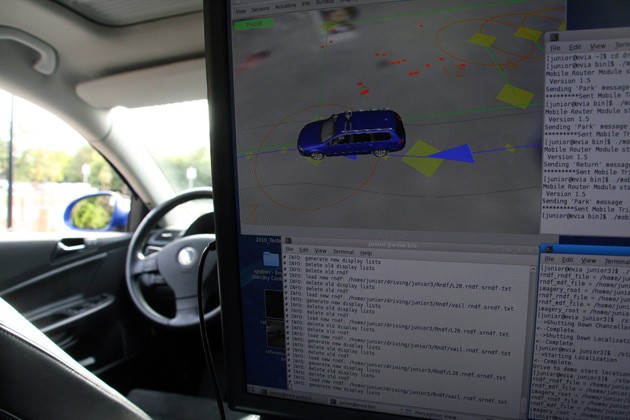

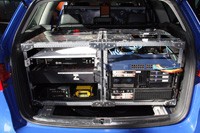
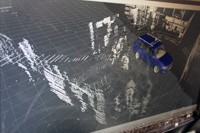
Picture this: You roll up to your favorite restaurant, open the door for your significant other and on the way inside you whip out your iPhone. You open up your Autonomous Valet Parking program, press the "Park" button and the vehicle drives off, finds a space, backs in, shuts off the motor and locks the doors. When you're done with your meal, you open the same app, hit the "Return" button on the virtual key fob and over your phone's data connection the car receives the message, starts the engine and drives to the restaurant's entrance. That's exactly what we experienced yesterday and we've got the video to prove it.
The video meant to be presented here is no longer available. Sorry for the inconvenience.
While the skeptical among you might think that the Passat was simply pre-programmed to park in that specific spot, after talking to a VW engineer, that's not the case. The vehicle was able to identify where it was in relationship to the parking "area" and slot into the available space. And that's just the tip of the autonomous iceberg.
As reported previously, Audi (through it's parent's at VW) and Stanford are working on a far more ambitious endeavor: Running up Pike's Peak in a TT S.
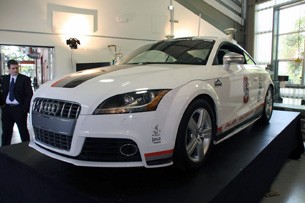
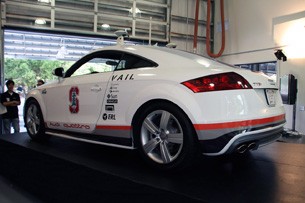
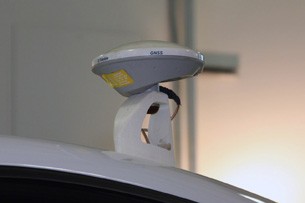

The coupe was on display at yesterday's event and while the team's plan to make a top speed run at El Mirage next month have been thwarted by Mother Nature (the dry lake bed isn't so dry), they've postponed that test until this summer and are furiously working away on the TT S ahead of its run up the mountain later this year.
Amazingly, the Audi bears no resemblance to the gutted and roof-racked Stanley and Stanley 2 – it's essentially a stock TT S with a few antennas and a computer in the trunk. The most common question VW's engineers are asked is can all this technology be scaled down? It's already been done, which means production applications are set to appear sooner than you'd think.
Naturally, we had to ask how hard the group would be pushing the coupe up Pike's Peak. Marcial Hernandez, Senior Engineer for VW's Driver Assistance and Electronics Research Lab, told us, "Faster than I can go." To which we asked, "Six-, seven-tenths?" "Maybe harder," was Hernandez' response.
Here's hoping we can score a ride in that this September.



Sign in to post
Please sign in to leave a comment.
Continue